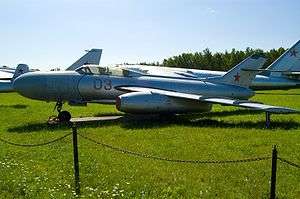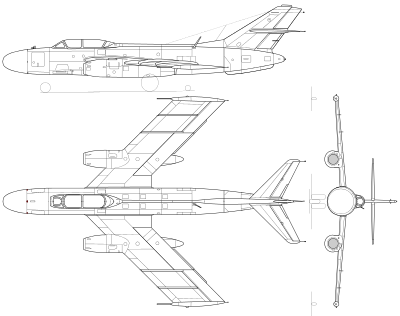Yakovlev Yak-25
| Yak-25 | |
|---|---|
 | |
| Yak-25 at Monino Aviation Museum | |
| Role | Interceptor fighter and reconnaissance aircraft |
| Manufacturer | Yakovlev |
| First flight | 19 June 1952 |
| Introduction | 1955 |
| Retired | 1967 |
| Primary users | Soviet Air Force Soviet Anti-Air Defense |
| Number built | 483 + 155 |
|
| |
The Yakovlev Yak-25 (NATO designation Flashlight-A/Mandrake) was a swept wing, turbojet-powered interceptor aircraft and reconnaissance aircraft built by Yakovlev and used by the Soviet Union.
Design and development
The Yak-25 originated from a need for long-range interceptors to protect the USSR's northern and eastern territory. The specification for a two-seat, twin-engine jet fighter and a related reconnaissance aircraft was issued by Joseph Stalin on 6 August 1951. The aircraft was to use the new Mikulin AM-5 turbojet. The first prototype, the Yak-120, flew on 19 June 1952.
The new design mounted the turbojets in pods in the wings, with bicycle landing gear, leaving the fuselage volume free for the two crewmen and a substantial fuel load, giving an unrefueled range (with external tank) of about 2,560 km (1,600 mi). The large, blunt nose contained the radome for the air-interception radar. Armament was two 37 mm NL-37L cannon with 50 rounds per gun.
Despite some significant problems the type was cleared for production in 1953 and the first were produced in 1954. Early production models, designated Yak-25, were delivered the following year, although they were not yet to operational capacity because of problems with the RP-6 'Sokol' (NATO Scan Three) radar. As a result, early aircraft used a modified version of the RP-1D 'Izumrud' (NATO High Fix) ranging radar instead. When the 'Sokol' was finally available, the newly equipped aircraft were designated Yak-25M,[1] with deliveries starting in January 1955. The Yak-25M received a number of other improvements, including recoil dampers for the cannon, upgraded AM-5A engines (with the same thrust), and a slight increase in fuel capacity. RAF RPF ELINT flights from October 1956 indicated that the Yak-25M had entered service, but that height-finding by ground-based radars was poor and so interception was ineffective above 35,000 feet.[1]
In 1955 and 1956 several Yak-25Ms were refitted as testbeds for air-to-air missile armament.
A reconnaissance derivative of the Yak-25, the Yak-25RV (Razvedchick Vysotnyj, "high-altitude reconnaissance"), was developed in 1959 (NATO codename 'Mandrake'). It had a completely new, long-span straight wing of 23.4 meters (more than twice that of the Yak-25M interceptor) with a total area of 55 square meters. Camera and sensor packs were added in the fuselage. Some versions may have retained one cannon.
Despite its low wing loading, the 'Mandrake's' altitude performance was marginal at best, with considerable engine problems at high altitudes, excessive vibration, and primitive equipment that imposed high workloads for the crews. The Soviet Air Force nevertheless kept the Yak-25RV in service until 1974. A few were used in the late 1970s for monitoring of radioactive contamination, with specialized sensors; these were designated Yak-25RRV. Efforts in 1971 to develop the 'Mandrake' as a high-altitude interceptor (Yak-25PA) proved unsuccessful.
The derivative Yak-26 was developed as a bomber, but only nine were built.
In 1961 a series of lightened 'Mandrakes' were produced as high-altitude target drones. The Yak-25RV-I was used as a manned target for unarmed (no live fire) interception practice, the Yak-25RV-II as a remote-piloted drone.
483 were built at Saratov plant, including 406 in Yak-25M variant, and 10 in Yak-25R reconnaissance variant. Additionally, 155 Yak-25RV reconnaissance high-altitude planes were built.
Operational history
Yak-25 was first displayed at Tushino in July 1955, and received the NATO designation Flashlight-A. They started to equip air defence units from 1955. They were considered easy to fly and popular among the crews. Quite common were engine breakdowns, mostly due to the low engine position when on the ground, which demanded clean airfields, but thanks to twin-engine arrangement, few such failures were fatal.
Their withdrawal started in 1963. The last Yak-25 interceptors were retired by 1967; the 'Mandrake' reconnaissance version soldiered on in various roles through the late 1970s. Like many other PVO interceptors of the Cold War era, the Yak-25M was not exported to the Warsaw Pact or other nations.
There was also another aircraft named Yak-25 - a light fighter prototype of 1947. After it lost a competition with the MiG-15 and Lavochkin La-15, the first Yak-25 program was abandoned and the designation Yak-25 was re-used for a new interceptor. See Yakovlev Yak-25 (1947) for the description of that aircraft.
Variants
- Yak-25
- First production version equipped with the RP-1D "Izumrud" radar. 67 aircraft built.
- Yak-25B
- Projected production version of Yak-125 Tactical nuclear bomber prototype.
- Yak-25M
- Basic production version with some minor improvements, upgraded AM-5A engines and new RP-6 "Sokol" radar. 406 aircraft built.
- Yak-25MG
- Some Yak-25M aircraft refitted with the 'Gorizont-1' system to allow them to be flown (via autopilot) by ground stations for ground control interception missions.
- Yak-25RV NATO reporting name "Mandrake"
- High-altitude reconnaissance version with new wing and camera and sensor packs in the fuselage. Some may have retained one cannon. 155 aircraft built.
- Yak-25RR
- Yak-25RV equipped with specialized sensors for monitoring of radioactive contamination.
- Yak-25RRV
- Yak-25RV equipped with specialized SIGINT sensors.
- Yak-25RV-I
- Manned target version for unarmed (no live fire) interception practice.
- Yak-25RV-II
- Remote-piloted drone for armed (live fire) interception practice.
Yak-25 family prototypes and projects
- Yak-2AM-11
- Reconnaissance and tactical reconnaissance projects powered by 2 x Mikulin AM-11(Tumansky R-11), cancelled as production of Tumansky R-11 allocated to MiG-21.
- Yak-13
- immediate predecessor of Yak-120, not built (re-use of designation from light tourer of 1946).
- Yak-25K
- Yak-25M with removed cannon, equipped Yak-25K-5 weapon system consisting of the "Izumrud" radar and four RS-1U (NATO AA-1 "Alkali") beam-riding missiles on the wings inboard of the engine pods. Small number built.
- Yak-25K-7L
- Yak-25M testbed for K-7L missiles. This weapon did not enter service and the aircraft version was abandoned.
- Yak-25K-75
- Yak-25M testbed for K-75 missiles. This weapon did not enter service and the aircraft version was abandoned.
- Yak-25K-8 (Yak-25S K-8)
- 'Two Yak-25K converted to Yak-25K-8 weapons system testbeds with two K-8 (NATO AA-3 'Anab') missiles. Two Yak-25M aircraft(Yak-25S K-8) were modified for carriage trials of the K-8 missile. Terminated in favor of the upcoming Yak-28P.
- Yak-25L (letayuschchaya laboritoriya - flying laboratory)
- Ejection seat testbed.
- Yak-25MR (morskoy razvedchik - maritime reconnaissance aircraft)
- Maritime reconnaissance aircraft prototype.
- Yak-25MSh
- Prototype of Radio controlled target drone, no production but many were converted to drones after service, but did not have MSh designation.
- Yak-25PA (perekhvahtchik aerostahtov - balloon interceptor)
- High-altitude balloon interceptor version of Yak-25RV, prototype only.
- Yak-25R
- Reconnaissance version with glazed nose for second crewman (navigator) and two cameras. Aircraft armed with 23mm cannon, 10 pre-production aircraft built.
- Yak-26
- Tactical nuclear bomber development, 9 aircraft built.
- Yak-120M
- Yak-120 re-engined with Mikulin AM-9A (AM-5 with 0stage added to compressor, can-annular combustion chamber and afterburning and improvements to armament and avionics.
- Yak-120MF
- Yak-120M converted to RD-9F engine testbed.
- Yak-122
- Tactical reconnaissance aircraft prototype evolved from the Yak-25 and the Yak2AM-11 project, powered by two RD-9F turbojets. This aircraft was converted into the Yak-27R tactical reconnaissance prototype.
- Yak-123
- prototype for Yak-26 tactical nuclear bomber.
- Yak-125B
- OKB designation for Yak-25B tactical nuclear strike aircraft prototype, carrying 1 x (spetspodveska - special slung load)
- Yak-SM-6
- Two production Yak-25's modified for testing K-6 AAM's, missile cancelled used for other test tasks.
Operators
Specifications (Yak-25)

General characteristics
- Crew: two
- Length: 15.67 m (51 ft 5 in)
- Wingspan: 10.94 m (35 ft 10 in)
- Height: 4.4 m (14 ft 5 in)
- Wing area: 28.94 m² (311.51 ft²)
- Empty weight: 5,675 kg (12,510 lb)
- Loaded weight: 8,675 kg (19,125 lb)
- Max. takeoff weight: 9,450 kg (29,760 lb)
- Powerplant: 2 × Mikulin AM-5 (RD-5A) turbojets, 23 kN (5,000 lbf) each
Performance
- Maximum speed: 1,090 km/h (680 mph)
- Range: 2,700 km with external tank (1,687 mi)
- Service ceiling: 15,200 m (50,000 ft)
- Rate of climb: 30 m/s (5,960 ft/min)
- Wing loading: 327 kg/m² (67 lb/ft²)
- Thrust/weight: 0.53
Armament
- Guns: 2× 37 mm Nudelman NL-37 cannon (50 rounds per gun)
See also
- Related development
- Aircraft of comparable role, configuration and era
- Avro Canada CF-100
- Gloster Javelin
- F-89 Scorpion
- F-94 Starfire
- Sud Aviation Vautour
- Lavochkin La-200
- Related lists
References
- Gordon, Yefim; Rybak, Boris (May 1993). "Yakovlev's Tactical Twins". Air International. Vol. 44 no. 5. pp. 243–249. ISSN 0306-5634.
External links
| Wikimedia Commons has media related to Yakovlev Yak-25. |
- Yak-25 at Ugolok Neba - description in Russian, photos and drawings